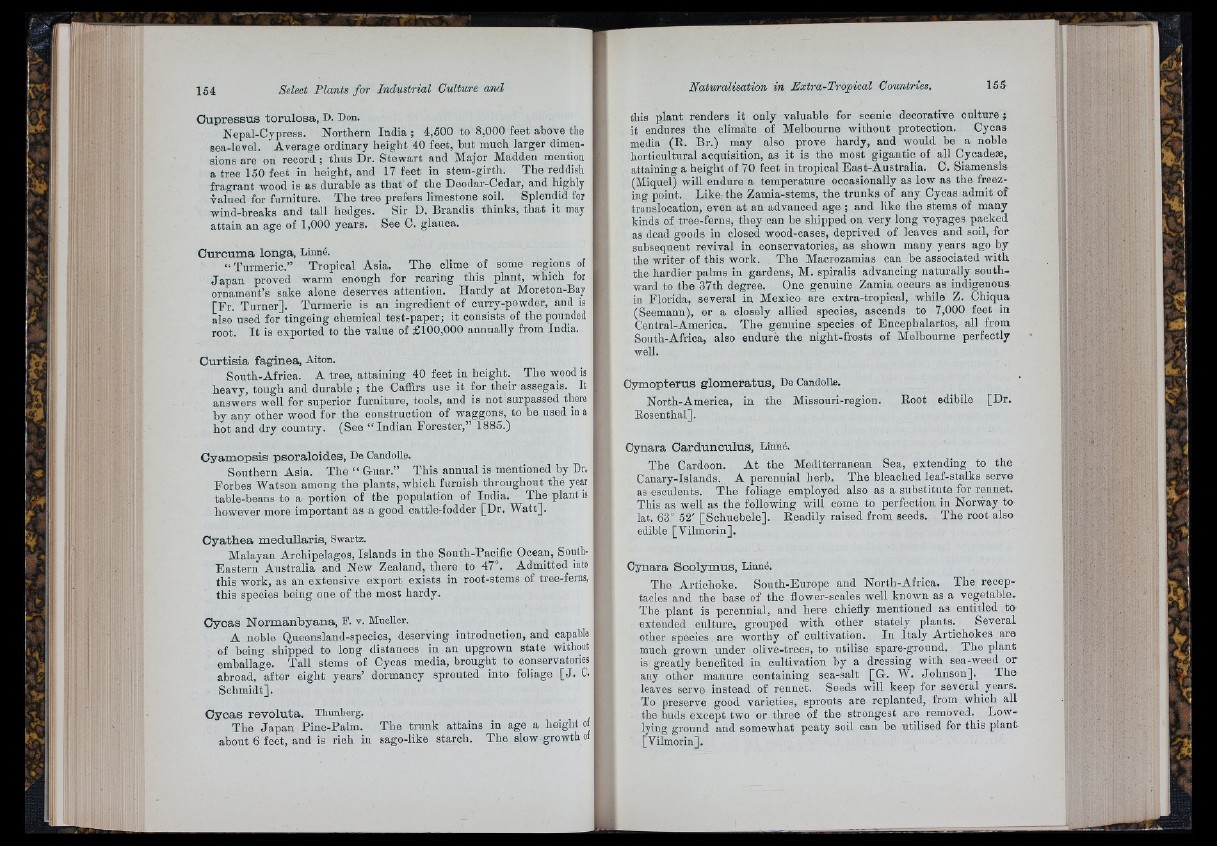
TIT
I '
C u p re s s u s to ru lo s a , D. Don.
Nepal-Cypress. Northern India ; 4,500 to 8,000 feet above the
sea-level. Average ordinary height 40 feet, hut much larger dimen-
sions are on record ; thus Dr. Stewart and Major Madden mention
a tree 150 feet in height, and 17 feet in stem-girth. The reddish
fragrant wood is as durable as th a t of the Deodar-Cedar, and highly
valued for furniture. The tree prefers limestone soil. Splendid for
wind-breaks and tall hedges. Sir D. Brandis thinks, th a t it may
attain an age of 1,000 years. See C. glauca.
C u r c um a lo n g a , Linné.
“ Turmeric.” Tropical Asia. The clime of some regions of
Jap an proved warm enough for rearing this plant, which for
ornament’s sake alone deserves attention. Hardy at Moreton-Bay
[F r. Turner]. Turmeric is an ingredient of curry-powder, and is
also used for tingeing chemical test-paper; it consists of the pounded
root. I t is exported to the value of £100,000 annually from India.
C u r tis ia fag in e a , Aiton.
South-Africa. A tree, attaining 40 feet in height. The wood is
heavy, tough and durable ; the Caffirs use it for their assegais, it
answers well for superior furniture, tools, and is not surpassed there
by any other wood for the construction of waggons, to be used in a
hot and dry country. (See “ Indian Forester,” 1885.)
C y am o p s is p so ra lo id e s , De Candolle.
Southern Asia. The “ Guar.” This annual is mentioned by Dr.
Forbes Watson among the plants, wliioh furnish throughout the year
table-beans to a portion of the population of India. The plant is
however more important as a good cattle-fodder [Dr. Watt].
C y a th e a m ed uU a ris, Swartz.
Malayan Archipelagos, Islands in the South-Pacific Ccean, Souti-
Easteru Australia and New Zealand, there to 47°. Admitted into
this work, as an extensive export exists in root-stems of tree-ferns,
this species being one of the most hardy.
C y c a s N o rm a n b y a n a , F- v. Mueller.
A noble Queensland-speoies, deserving introduction, aud capable
of being shipped to long distances in an upgrown state without
emballage. Tall stems of Cycas media, brought to conservatories
abroad, after eight years’ dormancy sprouted into foliage [J . C,
Schmidt].
C y c a s r e v o lu ta . Thunberg.
The Jap an Pine-Palm. The trunk attains in age a height o
about 6 feet, and is rich in sago-like starch. The slow growth of
this plant renders it only valuable for scenic decorative culture ;
it endures the climate of Melbourne without protection. Cycas
media (K. Br.) may also prove hardy, and would be a noble
horticultural acquisition, as it is the most gigantic of all Cycade^,
attaining a height of 70 feet in tropical East-Australia. C. Siamensis
(Miquel) will endure a temperature occasionally as low as the freezing
point. Like the Zamia-stems, the trunks of any Cycas admit of
translooation, even a t an advanced age ; and like the stems of many
kinds of tree-ferns, they can be shipped on very long voyages packed
as dead goods in closed wood-cases, deprived of leaves and soil, for
subsequent revival in conservatories, as shown many years ago by
the writer of this work. The Macrozamias can be associated with
the hardier palms in gardens, M. spiralis advancing naturally southward
to the 37th degree. Cne genuine Zamia occurs as indigenous
in Florida, several in Mexico are extra-tropieal, while Z. Chiqua
(Seemann), or a closely allied species, ascends to 7,000 feet in
Central-America. The genuine species of Encephalartos, all from
South-Africa, also endure the night-frosts of Melbourne perfectly
well.
C ym o p te ru s g lom e ra tu s , De Candolle.
North-America, in the Missouri-region.
Rosenthal].
Root edibile [Dr.
Cynara C a rd u n c u lu s , Linné.
The Cardoon. A t the Mediterranean Sea, extending to the
Canary-Islands. A perennial herb. The bleached leaf-stalks serve
as esculents. The foliage employed also as a substitute for rennet.
This as well as the following will come to perfection in Norway to
lat, 63° 52' [Sehuebele]. Readily raised from seeds. The root also
edible [Vilmorin].
Cynara S co ljrm u s, Linné.
The Artichoke. South-Europe and North-Africa. The receptacles
and the base of the flower-scales well known as a vegetable.
The plant is perennial, and here chiefly mentioned as entitled to
extended culture, grouped with other stately plants. Several
other species are worthy of cultivation. In Italy Artichokes are
much grown under olive-trees, to utilise spare-ground. The plant
is greatly benefited in cultivation by a dressing with sea-weed or
any other manure containing sea-salt [G . W. Johnson]. The
leaves serve instead of rennet. Seeds will keep for several years.
To preserve good varieties, sprouts are replanted, from which all
the buds except two or three of the strongest are removed. _ Low-
lying ground and somewhat peaty soil can he utilised for this plant
[Vilmorin].
i
fr
■[li;